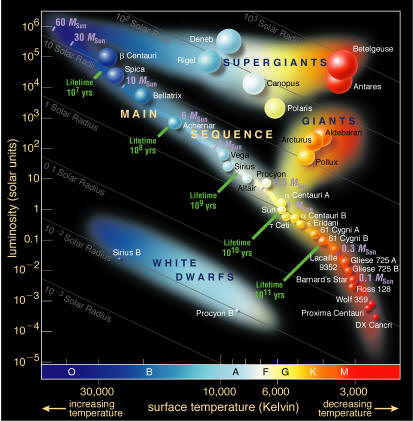If you make a plot of the brightness of a few thousand stars near us, against their color (or surface temperature) – a Hertzsprung-Russell diagram – you’ll see that most of them are on a nearly straight, diagonal, line, going from faint and red to bright and blue. That line is the main sequence (of course, you must plot the absolute brightness – or luminosity – not the apparent brightness; do you know why?).
As you might have expected, the discovery of the main sequence had to wait until the distances to at least a few hundred stars could be reasonably well estimated (so their absolute magnitudes, or luminosities, could be worked out). This happened in the early years of the 20th century (fun fact: Russell’s discovery was how absolute luminosity was related to spectral class – OBAFGKM – rather than color).
So why, then, do most stars seem to lie on the main sequence? Why don’t we find stars all over the H-R diagram?
Back in the 19th century, it would have been impossible to answer these questions, because quantum theory hadn’t been invented then, and no one knew about nuclear fusion, or even what powered the Sun. By the 1930s, however, the main outlines of the answers became clear … stars on the main sequence are powered by hydrogen fusion, which takes place in their cores, and the main sequence is just a sequence of mass (faint red stars are the least massive – starting at around one-tenth that of the Sun – and bright blue ones the most – about 20 times). Stars are found elsewhere on the Hertzsprung Russell diagram, and their positions reflect what nuclear reactions are powering them, and where they are taking place (or not; white dwarfs are cinders, slowly cooling). So, broadly speaking, there are so many stars on the main sequence – compared to elsewhere in the H-R diagram – because stars spend much more of their lives burning hydrogen in their cores than they do producing energy in any other way!
It took many decades of research to work out the details of stellar evolution – what nuclear reactions for what mass and composition of a star, how the size of a star reflects its internal structure and composition, how some stars can live on long after they should be white dwarfs, etc, etc, etc – and there are still many unanswered questions today (maybe you can help solve them?).
The Main Sequence (University of Utah), Main Sequence Stars (University of Oregon), and Stars (NASA’s Imagine the Universe) are three good places to go to learn more.
Dating a Cluster – A New Trick, V is For Valentine… V838, and Capture A FUor! are just three of the many Universe Today stories which feature the main sequence.
Astronomy Cast covers the main sequence from the point of view of stellar evolution in The Life of the Sun and The Life of Other Stars; be sure to check them out.
References:
NASA
Hyperphysics



